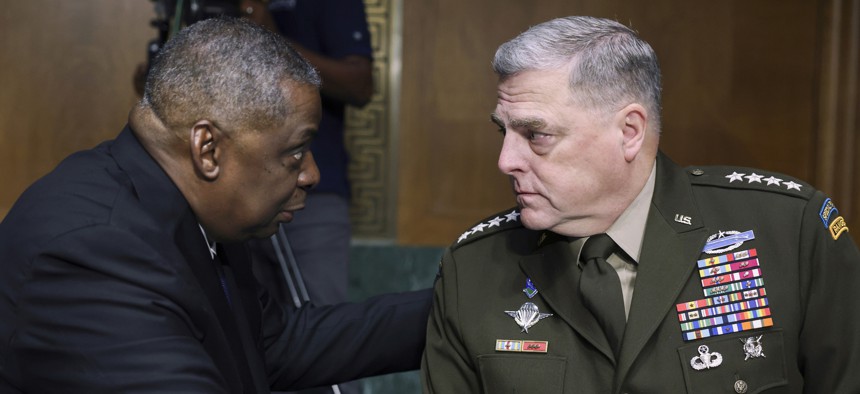
Secretary of Defense Lloyd Austin, left, and Chairman of the Joint Chiefs Chairman Gen. Mark Milley talk during a Senate hearing on June 17, 2021. Evelyn Hockstein/Pool via AP
Austin, Milley Say White House Was Advised to Keep US Troops in Afghanistan
The Afghanistan evacuation that resulted was “a logistical success but a strategic failure,” Milley said.
Joint Chiefs Chairman Gen. Mark Milley had cautioned the White House that a full withdrawal of forces would likely result in a Taliban takeover—but by the time President Joe Biden asked him directly in late August whether any forces should stay, it was too late, the nation’s top military leader testified Tuesday.
At a hearing of the Senate Armed Service Committee, members on both sides of the aisle had pointed questions about the evacuation and the longer-term mistakes, and the hearing was the first time that both Milley and U.S. Central Command chief Gen. Frank McKenzie were able to publicly state that they had wanted to keep as many as 2,500 U.S. forces in Afghanistan post-withdrawal.
Last month, Biden told ABC’s George Stephanopolous that none of the commanders had advised him to leave a small troop presence in Afghanistan.
Defense Secretary Lloyd Austin and Milley testified that commanders’ concerns — that a full withdrawal could hasten Taliban takeover—were conveyed to the Biden White House in the months leading up to the Aug. 31 withdrawal deadline.
Milley had already pushed back once before, when he received an order Nov. 11 from former President Donald Trump to withdraw all forces by Jan. 15. After further consultation the Pentagon convinced the White House to keep 2,500 troops in country.
It wasn’t until the Taliban had taken control of Afghanistan, Milley said, that the chairman was asked for his best military assessment on leaving any troops past the Aug. 31 withdrawal deadline. The president asked for his view on Aug. 25, he said.
Milley said at that point, it would have required ordering thousands of additional troops to land in Kabul by Sept. 1 to fight ISIS-K and thousands of Taliban fighters,
“That would have resulted in significant casualties on the U.S. side,” Milley said. His recommendation was to continue with the full drawdown.
The hearing marked the beginning of what’s likely to be a drawn-out process in Congress of identifying what happened—and pinning blame.
“We need to consider some uncomfortable truths,” the defense secretary said in his opening remarks. “We did not fully comprehend the depth of corruption and poor leadership in their senior ranks… We did not anticipate the snowball effect caused by the deals that Taliban commanders struck with local leaders in the wake of the Doha agreement, that the Doha agreement itself had a demoralizing effect on Afghan soldiers, and that we failed to fully grasp that there was only so much for which—and for whom—many of the Afghan forces would fight.”
“We helped build a state, but we could not forge a nation,” Austin said.
Members of Congress from both parties have expressed doubt that the Taliban’s swift victory was unforeseeable, particularly since years worth of reports from the Special Inspector General for Afghanistan Reconstruction had warned about hollow and easily corrupted elements of the Afghan National Army and its leadership ranks.
“Throughout the spring, we saw many districts quickly fall to the Taliban—many without a shot fired,” said SASC ranking member Sen. Jim Inhofe, R-Okla. “Members of this committee, on both sides of the aisle, spent months urging the administration to evacuate Americans and our Afghan partners sooner. But President Biden and his advisers didn’t listen to his combat commander. He didn’t listen to Congress. And he failed to anticipate what all of us knew would happen.”
Austin said he strongly disagreed that anyone predicted the country falling to the Taliban as fast as it did.
“The fact that the Afghan army we and our partners trained simply melted away—in many cases without firing a shot—took us all by surprise. It would be dishonest to claim otherwise.”
But responsibility for Kabul’s fall does not fall solely on the Biden administration, Milley told the lawmakers, noting he had advised the Trump administration last fall not to pull all U.S. troops from the country.
“My analysis was that an accelerated withdrawal without meeting necessary conditions risks losing the substantial gains made in Afghanistan, damaging U.S. credibility, and could precipitate a general collapse of the ANDSF [Afghan National Defense and Security Forces] and the Afghan government resulting in a complete Taliban takeover or a general civil war,” Milley testified. But “this has been a 10-year multi-administration drawdown, not a 19-month or a 19-day withdrawal.”
One early point, and perhaps one of the few where Austin and Milley will reveal a fissure in the wake of Kabul, is the impact it’s had on the United States’ standing with partners around the world.
"Damage is one word that could be used, yes," Milley said in response to Senate questioning.
"I think our credibility remains solid,” Austin said a moment later.
On the evacuation itself, the two leaders were unified in their message: the military did everything it could do, within the limits set by the Biden administration and the then-looming Sept. 1 deadline.
Military planning for the evacuation itself had begun by May of this year. In the weeks leading up to the fall of Kabul, and even in the days before, as the Taliban encircled the city, Pentagon spokesman John Kirby would not call the military’s increased presence and movements a non-combatant evacuation—because the State Department was in charge and had not called for one.
Austin said the State Department’s late call for NEO and the lack of having Afghans fully cleared with Special Immigrant Visas to depart created one of the most complex and dangerous airlifts in the military’s history.
By the time Kabul fell, the State Department had only cleared a few thousand of the estimated tens of thousands of Afghans who had worked for the U.S. during the 20-year-war and whose lives were now at risk.
Americans were left behind too.
“We are still working to get Americans out who wish to leave. We did not get out all of our Afghan allies enrolled in the Special Immigrant Visa program,” Austin said. “We take that very seriously.”
But much of that blame also lies on the hundreds of military supervisors or contractors who had hired those Afghans, who departed the country, moved on or retired without providing all of the paperwork Afghan interpreters and others would need to get the visa, said Sen. Jeanne Shaheen, D-N.H.
“DOD has been cited as the major problem in getting those documents,” Shaheen said.
Austin said, “As for when we started evacuations: we offered input to the State Department’s decision, mindful of their concerns that moving too soon might actually cause the very collapse of the Afghan government that we all wanted to avoid, and that moving too late would put our people and our operations at greater risk.”
By the time the State Department cleared the way for the military to begin official non-combatant evacuations over the weekend, Kabul had fallen and the flag had already been taken down from the U.S. Embassy. Diplomatic staff fled to Hamid Karzai International Airport. A small but growing force of Marines from the 24th Marine Expeditionary Unit were already on hand, but they were quickly outnumbered by thousands of Afghans who rushed to the airport desperate to flee.
“In the span of just two days—from Aug. 13 to 15—we went from working alongside a democratically elected, long-time partner government to coordinating warily with a long-time enemy,” Austin said. “To be clear, those first two days were difficult,” Austin said.
The Pentagon has also been criticized by lawmakers for closing Bagram Air Base before all U.S. citizens had been evacuated, which made the Kabul airport the single point of failure for getting out.
Austin pushed back on that too.
“Retaining Bagram would have required putting as many as five thousand U.S. troops in harm’s way, just to operate and defend it,” the secretary said. “And it would have contributed little to the mission that we had been assigned: to protect and defend our embassy some 30 miles away. That distance from Kabul also rendered Bagram of little value in the evacuation. Staying at Bagram—even for counter-terrorism purposes—meant staying at war in Afghanistan, something that the president made clear he would not do.”
Democratic senators sought to deflect blame from Biden by asking about how the Doha agreement reached by President Donald Trump with the Taliban had hurt the war effort.
“The decision to leave Afghanistan was made by President Trump...on Feb. 29, 2020, where we committed to leave by a date certain,” said Sen. Angus King, I-Maine.
King asked Milley on whether the Trump administration had tried to enforce the agreement, which required the Taliban to conduct negotiations with the Afghan government and agree on a permanent ceasefire as a condition for the U.S. withdrawal. Milley responded that the group met the condition to not attack American troops, but no other requirement in the deal.
Sen. Tammy Duckworth, D-Ill., said that the withdrawal from Afghanistan was “influenced by previous decisions” made by four administrations and 11 sessions of Congress.
“No party should be looking to score cheap partisan political points off a multi-decade nation-building failure that was bipartian in the making,” Duckworth said.
Sen. Jack Reed, D-R.I., the chairman of the committee, also cited the Doha agreement as an integral part of the broader review of how the withdrawal happened. But he also placed blame even further back, saying lawmakers should also evaluate the role of President George W. Bush’s “catastrophic pivot to Iraq” in 2003 when considering the final outcome in Afghanistan.
“The Bush administration’s invasion of Iraq drew critical resources, troops, and focus away from the Afghan theater,” Reed said. “Our best opportunity in Afghanistan was squandered, and we were never able to get back on track.”
Republicans, however, pushed back on the idea that Trump was to blame. Sen. Tom Tillis, R-.N.C., contended that Biden did not seem to be stuck with Trump’s other decisions, including exiting the Paris climate accord, which Biden has rejoined; or abandoning the Iran nuclear deal, which Biden has said he wants to restart.
“I don’t buy the idea that this president was bound by a decision made by a prior president. This was not a treaty, and it was clearly an agreement where the Taliban were not living up to it,” Tillis said. “President Biden could have come in, reasserted conditions and completely changed the timeline.”
Jacqueline Feldscher contributed to this report.







